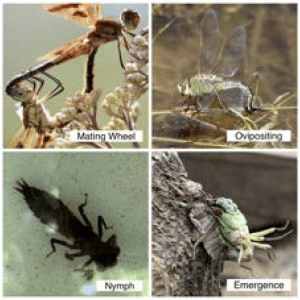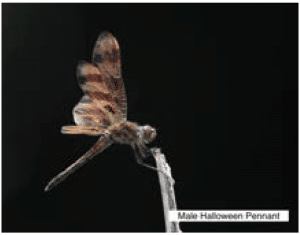By Cindy Andrews

Dragonflies and damselflies, from the order Odonata, really spark my imagination and love of learning. I spend countless hours “hunting” and photographing them from early March through November each Year.
Odes have a fascinating life cycle. When mating, adults often form a mating “wheel” with the male attaching his abdomen to the female’s head while she attaches her abdomen to his thorax for fertilization. Fertilized eggs are then laid by females ovipositing directly in freshwater streams or ponds or on vegetation in those habitats. The eggs hatch into nymphs that live underwater for anywhere from 1-5 years. Like a caterpillar, they go through several instar stages shedding exoskeleton each time. At this stage they have no resemblance to a dragonfly! When ready, they climb up a reed or stick and emerge from the exoskeleton as a mature dragonfly. After drying its wings, it begins its final life stage intent on two things: eating and mating. As an adult, they live for only a few weeks to a few months, depending on species.

Besides being gorgeous creatures, dragonflies are helpful to our environment. First, they are indicators of clean water. Scientific studies of their numbers and health can quickly reveal changes in water ecosystems. As nymphs they feast on mosquito larvae and other harmful aquatic organisms. As adults they feed on many insects, good and bad, including termites, biting flies, and gnats. They also serve as prey food for birds, frogs, and others. Ode habitat varies from stagnant pools, slow and fast creeks both in the open and forested, river banks, and even saltwater marshes. Different odes prefer different habitats.
Dragon and damsel season has started. I found my first of the year on March 22: Fragile Forktails at Tuckahoe Creek Park. Want to hunt dragons? Explore the various aquatic habitats. Check the reeds and sticks where they like perch. Look up – they frequently rest in tree leaves! To identify what you’ve seen, try iNaturalist if you have a photo, the “Dragonfly and Damselfly Field Guide and ID” app, or Dennis Paulsen’s “Dragonflies and Damselflies of the East.” Happy hunting!
